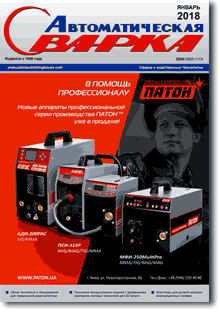| 2018 №01 (02) |
DOI of Article 10.15407/as2018.01.03 |
2018 №01 (04) |

Avtomaticheskaya Svarka (Automatic Welding), #1, 2018, pp. 22-28
Calculation-experimental investigation of thermal fields in the process of nonstationary soldering
M.V. Kulinich1, V.N. Bezpalchuk2, S.G. Kosintsev1, A.M. Gusak2, T.V. Zaporozhets2 and A.I. Ustinov1
1E.O. Paton Electric Welding Institute of the NAS of Ukraine 11 Kazimir Malevich Str., 03150, Kyiv, Ukraine. E-mail: office@paton.kiev.ua
2Bohdan Khmelnytsky National University of Cherkassy 81 Shevchenko boulevard, 18031, Cherkassy, Ukraine
Abstract
In the work theoretical and experimental methods were used to investigate temperature fields in the conditions of soldering the metal plates, contacting with a heated body. To determine thermal conditions, necessary to provide soldering (melting of solder in the joint zone), calculation of temperature distribution with time in the joint zone was carried out, depending on characteristics of «heater-plate-solder-plate» system and thermal resistance in contacts between the system elements. It is shown that by comparing the theoretically calculated and experimentally measured thermograms, it is possible to determine thermal resistance in the contact zones. On the basis of the obtained values of thermal resistance in the contacts, the modeling of thermal fields in the systems with the arbitrary dimensions of elements was carried out. 13 Ref., 7 Figures.
Keywords: thermal fields, non-stationary process, method of finite differences, reaction soldering, permanent joint, multilayer foil, local heating
Received: 27.11.17
Published: 15.02.18
References
- Merzhanov, A.G., Borovinskaya, I.P. (1972) Self-propagating high-temperature synthesis of refractory inorganic compounds. Akad. Nauk SSSR, 204, 366–369 [in Russian].
- Sytschev, A.E., Vadchenko, S.G., Boyarchenko, O.D. et al. (2013) SHS welding by thermal explosion: Ti–Ti and Ti–NiAl joints. J. of Self-Propagating High-Temperature Synthesis, 22(2), 99–102. https://doi.org/10.3103/S106138621302009X
- Ren-Kae Shiue, Chen Chia-Pin, Wu Shyi-Kaan (2015) Infrared brazing of Ti50Ni50 shape memory alloy and 316L stainless steel with two silver-based fillers. and Mater. Transact. A, 46(6), 2364–2371. https://doi.org/10.1007/s11661-015-2830-7
- Nothdurft, S., Springer, A., Kaierle, S. et al. (2016) Laser soldering and brazing of steel-aluminum sheets for tailored hybrid tubes. Journal of Laser Applications, 28, 022429 https://doi.org/10.2351/1.4943996
- Jacobson, D.M., Humpston, G. (2005) Principles of brazing. USA.
- Morsi, K. (2001) Review: Reaction synthesis processing of Ni–Al intermetallic materials. Sci. & Engin. A, 299(1–2), 1–5. https://doi.org/10.1016/S0921-5093(00)01407-6
- Weihs, T., Barmak, K., Coffey, K. (2014) Fabrication and characterization of reactive multilayer films and foils. Metallic Films for Electronic, Optical and Magnetic Applications: Structure, Processing and Properties, 40, 160–243. https://doi.org/10.1533/9780857096296.1.160
- Ustinov, A.I., Olikhovska, L.O., Melnichenko, T.V., Shyshkin, A.E. (2008) Effect of overall composition on thermally induced solid-state transformations in thick EB PVD Al/Ni multilayers. and Coat. Tech., 202, 3832–3838.
- Kravchuk, M.V., Ustinov, A.I. (2015) Influence of thermodynamic and structural parameters of multilayer foils on SHS process characteristics. The Paton Welding J., 8, 8–13. https://doi.org/10.15407/tpwj2015.08.02
- Farlow, S. (1985) Partial differential equations for scientists and engineers. Moscow, Mir [in Russian].
- Tikhonov, A.N., Samarsky, A.A. (1977) Equations of mathematical physics. Moscow, Nauka [in Russian].
- Zaporozhets, T.V., Gusak, A.M., Ustinov, A.I. (2010) SHS reactions in nanosized multilayers – analytic model versus numeric model. J. of Self-Propagating High-Temperature Synthesis, 19(4), 227–236. https://doi.org/10.3103/S1061386210040011
